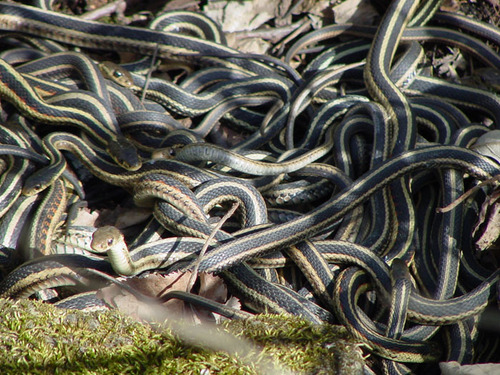Growing up in northeast Ohio I can remember being out with my
friends in the woods looking for “cool critters”. While we would collect tadpoles and catch frogs, we never
stumbled upon a snake. Yet, as I patrolled off the trail in our woods into the
unknown, my 9 year old self worried about an encounter with the deadly venomous
snakes I had seen on Animal Planet and The Discovery Channel. Such fears, I was told by parents,
teachers, and other 9 year olds, were unfounded because “there aren’t venomous
snakes in Ohio! They’re all down
south and out west!”.
Myth: There are no venomous snakes in Ohio.
Fact: There are three known
species of venomous snakes native to Ohio.
It wasn’t
until I took Herpetology at Miami University that I learned that
there are three venomous snake species native to Ohio: the timber rattlesnake (Crotalus horridus), the eastern
massausaga snake (Sistrurus catenatus),
and the northern copperhead snake (Agkistrodon
contortrix). I thought it
might be useful to give a brief overview of each species.
Family: Viperidae
Scientific: Agkistrodon
contortrix
Common Name: Northern copperhead
Counties found in Ohio (since 1976): Adams,
Scioto, Jackson, Meigs, Vinton, Athens, Hocking, and Washington.
Description: The northern copperhead can be easily identified by its
reddish, copper-colored head followed by a pink-light brown body with a dark
brown hourglass pattern. As with all poisonous snakes, it has a triangulated
head with elliptical eyes and a heat sensing loreal pit. Its average size varies between 24-36”
long.
Habitat: The copperhead thrives in a number of areas including:
oak-hickory hillsides with plenty of rock crevices, swamp boarders, and
foundations from old, abandoned buildings. They show a strong preference to moist habitats.
Diet:
Primary food is mice.
However, they will consume small birds, frogs, and other small snakes.
Behavior: The copperhead is a “social” snake in that it will
overwinter in communal dens with both its own kind and other species. These overwintering dens are usually
near a rocky ridge on a south-facing slope. As with most snakes, copperheads are generally not
aggressive, and their bites are rarely fatal. They are most active during their two mating seasons: Late
February-April and Late August-October.
Conservation Status: Least concern
Family: Viperidae
Scientific: Crotalus horridus
Common name: Timber rattlesnake
Counties found in Ohio (since 1976): Adams, Scioto, Pike, Jackson, Gallia,
Vinton, Hocking, and Ross.
Description: The average adult timber rattlesnake in Ohio is around
38-40” long, although they have been recorded to be as long as 60”. They experience two distinct color
phases: the young are typically yellow with a black and brown “chevron-like”
pattern, while the adults typically will have much darker, almost black, skin,
but still with the brown “chevron like” pattern. As with all poisonous snakes, it has a triangulated head
with elliptical eyes and a heat sensing loreal pit. As characteristic of a rattlesnake, its tail has a rattle,
which begins to develop after the first time it sheds its skin, that it uses to
warn trespassers of its presence.
Habitat: Timber rattlesnakes require
rocky hillsides with underground crevices for overwintering a “summer” habitat
consisting of mixed deciduous forest with lots of leaf-litter, some fallen
trees, and a mostly closed canopy for cover. The average home range for males, females (barren), and
pregnant females has been reported to be around 160, 42, and 9 acres,
respectively.
Diet:
Timber rattlesnakes are “sit and wait” predators. Their venom works by causing massive
hemorrhaging (bleeding) in their prey.
They will let their prey escape and bleed to death. Then, using chemosensory cues, it will
follow the scent trail to its meal.
Timber rattlesnakes have been known to eat shrews, moles, bats, mice,
rats, chipmunks, squirrels, rabbits, and birds.
Behavior: Generally considered relatively docile and will prefer
to escape rather than attack.
However, if provoked it will attack/behave aggressively. However, due to already low population
numbers and their secretive nature, the chances of running into one of these
snakes is very low.
Conservation Status: Endangered. Timber rattlesnakes don’t
reach maturity until later in life (around 11 years) and females only reproduce
a few times in life. Combine this
with habitat destruction and you have a recipe for population decline.
Family: Viperidae
Scientific: Sistrurus catenatus
Common Name: Eastern massausauga
Counties found in Ohio (since 1976): Warren,
Clark, Champaigne, Licking, Wyandot, Wayne, Trumbull, and Ashtabula
Description: Small (18-24”) and stout
bodied, the eastern massasauga snake varies in color from brownish gray to
black with dark blotches running the length of the body. In addition to the 29-50 dorsal
blotches, three smaller rows of dark spots can be seen on both sides of the
body. As with all
poisonous snakes, it has a triangulated head with elliptical eyes and a heat
sensing loreal pit. As with the timber rattlesnake, the eastern massasauga has
a rattle.
Habitat: The word “massasauga” is derived from the Chippewa Indian language and refers to
marshy areas associated with the mouth of a river. Fittingly, today’s populations in Ohio persist in bogs,
swamps, and wet praries. They
prefer low lying, poorly drained meadows.
They will overwinter in moist soil areas. Their home range is relatively small (11,753 yards), and
they only move around 30 feet per day.
They can be found resting under flat boards or other discarded material,
and they bask in the sunlight in openings and clearings.
Diet:
Small mammals, other small snakes, frogs, salamanders, toads, and
young birds
Behavior: Very sluggish and will rarely make an attempt to bite
unless they have been aroused.
Venom is extremely poisonous, but typical bites do not usually deliver
enough to be fatal. Both males and
females are known to be most active at night. They will also remain active in the day when the temperature
is optimal. They are most active
and easily found in April, May, and October.
Conservation Status: Listed as
endangered in Ohio. These snakes
were believed to have once inhabited all of the scattered prairies in Ohio, but
extensive farming drastically reduced their numbers.




























